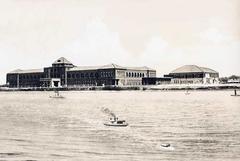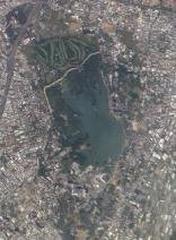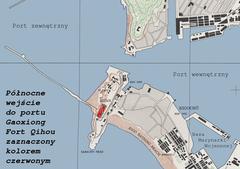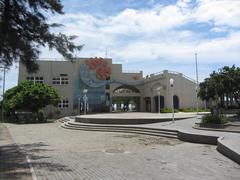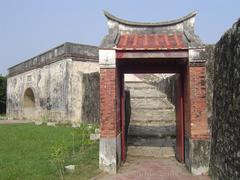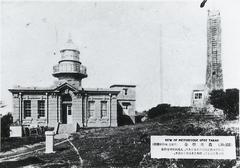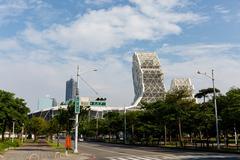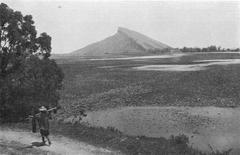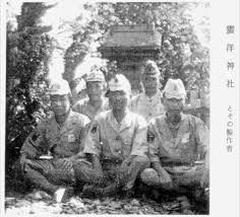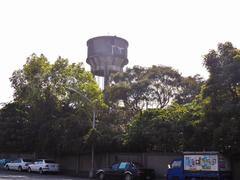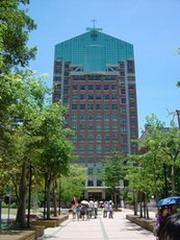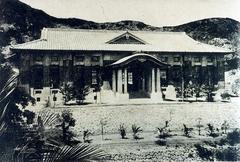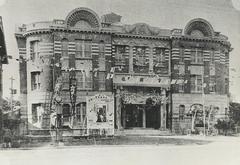Jiuqutang Station: Visiting Hours, Tickets, and Comprehensive Travel Guide to Kaohsiung’s Historical Landmark
Date: 03/07/2025
Introduction: Jiuqutang Station’s Historical and Cultural Significance
Set in the lush Dashu District of Kaohsiung, Taiwan, Jiuqutang Station (九曲堂車站) is an enduring symbol of the region’s transportation history and cultural evolution. Since its establishment in 1907 under Japanese colonial rule, the station has played a pivotal role in modernizing Taiwan’s southern transport network and bolstering the sugar and agricultural industries, ultimately shaping Kaohsiung’s economic trajectory.
Today, Jiuqutang Station is celebrated for its well-preserved early 20th-century wooden architecture, seamlessly coupled with modern amenities and accessibility features. It is not only a functioning hub for the Taiwan Railways Administration (TRA) Western Line but also a vibrant heritage site. Visitors are invited to admire its historic gabled roofs, wooden interiors, and vintage signage, while exploring the nearby Old Iron Bridge, Dashu Old Street, and Taiwan Pineapple Museum—each underscoring the area’s rich agricultural and Hakka cultural heritage.
Open daily, Jiuqutang Station welcomes both everyday commuters and cultural travelers, particularly during community festivals like the Tung Blossom Festival. With ongoing preservation efforts and plans for enhanced digital engagement, the station remains a relevant and engaging destination for all ages. For the latest visiting hours, ticketing details, and travel advice, consult the official Taiwan Railways Administration and Kaohsiung Travel resources.
Table of Contents
- Introduction: Jiuqutang Station’s Historical and Cultural Significance
- History and Architectural Heritage
- Visiting Hours, Ticket Information & Accessibility
- Community Role & Cultural Events
- Station Facilities and Passenger Services
- Getting There: Transport and Connectivity
- Nearby Attractions
- Practical Travel Tips
- Frequently Asked Questions (FAQ)
- Conclusion & Recommendations
- References
History and Architectural Heritage
Jiuqutang Station was constructed in 1907 as part of Taiwan’s modernization under Japanese administration, serving as a strategic point in the TRA Western Line. Its original wooden building, a blend of Japanese and Western architectural motifs, reflects the era’s public works philosophy. The station’s name, “Nine Turns Hall,” references the meandering Gaoping River nearby.
Initially, the station was integral to the transportation of sugar and agricultural products, fueling Kaohsiung’s economic growth. Over the decades, it has undergone several renovations—most notably in 2016—balancing the preservation of historical features with the needs of contemporary travelers. The restoration maintained the iconic wooden beams, decorative motifs, and gabled roofs, making the station a living museum and a rare example of early 20th-century railway architecture in southern Taiwan.
Adjacent to the station, the former Jiuqutang Taifang Chamber of Commerce Pineapple Cannery (founded in 1925) now houses the Taiwan Pineapple Museum, further cementing the area’s role in regional fruit processing and exportation (takao.kcg.gov.tw).
Visiting Hours, Ticket Information & Accessibility
- Visiting Hours: Jiuqutang Station operates daily from approximately 5:30 AM to 11:00 PM, in accordance with TRA train schedules (Taiwan Railways Administration).
- Ticketing: Standard TRA ticket prices apply for train travel to and from Jiuqutang Station. Tickets may be purchased at staffed counters, automated vending machines, or online via the TRA website. Use of EasyCard or iPass is recommended for seamless fare payment and discounts.
- Accessibility: Thanks to the 2016 renovation, the station is wheelchair accessible, with ramps, tactile guides for visually impaired visitors, and accessible restrooms.
There is no entrance fee to visit the station itself. For up-to-date ticket prices and schedules, always refer to the TRA official website.
Community Role & Cultural Events
Jiuqutang Station acts as a hub for Dashu’s vibrant Hakka community. Its proximity to the Old Gaoping River Iron Bridge—a national historic monument—and Dashu Old Street makes it a focal point for local festivals and cultural celebrations such as the Tung Blossom Festival.
The station is a favored spot for photographers and artists, drawn by its nostalgic architecture and tranquil surroundings. Community events frequently utilize the station’s public spaces, reinforcing its role as both a transit point and a gathering place.
Station Facilities and Passenger Services
Layout and Amenities
- Platforms: Two side platforms with accessible overpasses, elevators, and ramps.
- Ticketing: Staffed counters and self-service machines accept cash, credit cards, and transportation cards.
- Waiting Areas: Air-conditioned waiting halls with seating, vending machines, and clean restrooms (including accessible stalls and baby-changing facilities).
- Wi-Fi: Free Wi-Fi is available in main waiting areas.
- Convenience Stores: Adjacent shops and food stalls offer light meals and snacks.
- Parking: Bicycle racks and limited car parking; eco-friendly commuting encouraged.
Passenger Information
- Real-time bilingual (Chinese/English) schedules are displayed.
- Staff generally offer assistance, though English proficiency may be limited.
- Station signage covers essential information in both Chinese and English.
Getting There: Transport and Connectivity
Train Services
Jiuqutang Station is served by Local, Fast Local, and Express trains on the TRA Western Line. Trains connect to Kaohsiung Main Station, Zuoying (for High-Speed Rail), and Tainan.
Bus Connections
Key bus routes include 大樹祈福線, 橘7A, 大樹線, 8010, and 8010區間車, with stops just a short walk from the station entrance. Buses operate from early morning until evening, providing access to nearby attractions such as Fo Guang Shan Buddha Museum and Dashu Old Street. For route planning, consult the Moovit app or the Kaohsiung iBus app.
Urban Transit Integration
While not directly linked to Kaohsiung’s MRT or LRT, Jiuqutang is a short train ride from Kaohsiung Main Station, where transfers to MRT lines are available. EasyCard/iPass can be used across all public transport modes.
Taxis & Ride-Hailing
Metered taxis and ride-hailing services (like Uber) are available. Have your destination written in Chinese for convenience.
Nearby Attractions
- Taiwan Pineapple Museum: Located adjacent to the station, this museum highlights the region’s pineapple processing legacy and offers interactive exhibits and tastings (takao.kcg.gov.tw).
- Dashu Old Street: Traditional shops, eateries, and cultural events within walking distance.
- Fo Guang Shan Buddha Museum: Major religious and cultural destination accessible via local bus.
- Old Iron Bridge: Historic steel railway bridge popular with history enthusiasts and cyclists.
- Cycling & Walking Trails: Scenic routes along the Gaoping River.
Practical Travel Tips
- Language: English signage is present, but a translation app or key Mandarin phrases are helpful.
- Payment: Use EasyCard or iPass for convenience and discounts on trains and buses.
- Apps: Download Moovit and Kaohsiung iBus for real-time public transit info.
- Weather: Kaohsiung is often hot and humid; bring sun protection and stay hydrated.
- Best Visiting Time: Spring (March–May) is ideal for festivals and moderate weather.
- Accessibility: Facilities are basic but adequate; inquire with staff for additional assistance.
Frequently Asked Questions (FAQ)
Q1: What are Jiuqutang Station’s opening hours?
A: The station operates from approximately 5:30 AM to 11:00 PM daily, based on train schedules.
Q2: Is there an entrance fee for Jiuqutang Station?
A: No, there is no entrance fee—only train fares apply.
Q3: How do I purchase tickets for Jiuqutang Station?
A: Buy tickets at station counters, vending machines, or online. EasyCard/iPass users can tap and go.
Q4: Is Jiuqutang Station accessible for disabled visitors?
A: Yes, accessibility improvements include ramps, elevators, and tactile guidance.
Q5: What are the top attractions near Jiuqutang Station?
A: Taiwan Pineapple Museum, Dashu Old Street, Fo Guang Shan Buddha Museum, and cycling trails along the Gaoping River.
Q6: Are guided tours available?
A: Seasonal guided tours may be arranged through local tourism offices; check the Kaohsiung Travel website for details.
Conclusion & Recommendations
Jiuqutang Station seamlessly blends historical charm with modern convenience, offering visitors a unique gateway to Kaohsiung’s rich cultural landscape. Its preserved architecture, community role, and proximity to major attractions make it a must-visit for anyone exploring southern Taiwan. To maximize your experience:
- Use EasyCard/iPass for travel.
- Visit during spring festivals for cultural events.
- Combine your station visit with the Taiwan Pineapple Museum and Dashu Old Street.
- Check official sources for the latest schedules and event information.
For real-time updates, download the Audiala app and follow our social media channels.
References
- Taiwan Railways Administration
- Kaohsiung Travel
- Moovit App - Jiuqutang Station
- Taiwan Pineapple Museum, Kaohsiung City Government
- Kaohsiung iBus App
- Kaohsiung Urban Development
- Kaohsiung Travel Guide
- Things to Do in Kaohsiung
